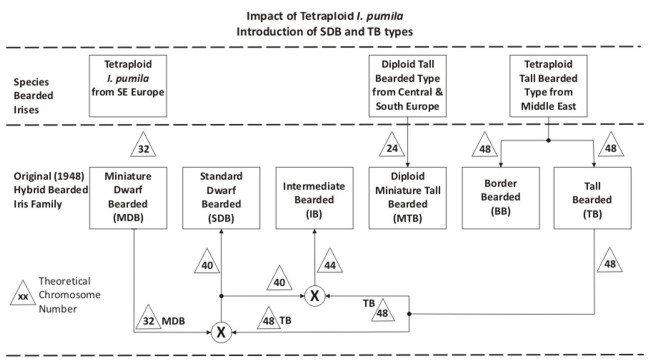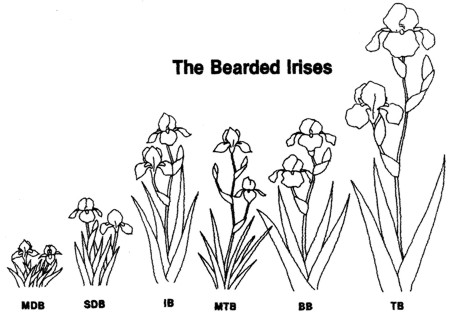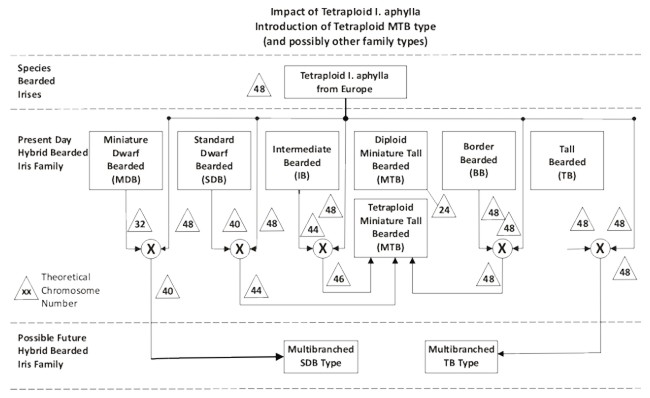- King County Iris Society
- Louisiana Irises: bright colors for boggy areas.
- Siberian Irises: gracefull foliage and a wide range of colors.
- Pacific Coast Irises: an amazing array of colors and patterns.
- Bearded Irises: colors and sytles to fit the needs of any gardener!
- Japanese Irises: magnificently majestic; eye-catching in the garden.
- Spuria Irises: tall and stately, ideal for landscape backgrounds.
- Species Irises: landscape marvels; genetic parents of modern hybrids.
Species irises are those natural irises found in the wild altered over the centuries with the aid of bees, birds, the wind and the like. We humans came along and started our own breeding of these species irises. The resulting products are referred to as hybrid irises. Most modern bearded irises are hybrids, having started as species followed by many generations of hybridizing by humans. In fact, formal human hybridizing programs of bearded irises date as far back to at least to the 1600's.
There are a great variety of species type bearded irises that range in height from dwarf irises to those taller bearded over four feet in height. At the time that the American Iris Society (AIS) had been founded in 1920 the primary emphasis was on the diploid tall bearded (TB) irises. There were also a number of shorter bearded species irises available at the time, but none had really caught on. What did catch on were the stately appearances of a family of tall diploid bearded irises that were being hybridized extensively and were commercially available.Tall species type bearded irises were discovered in Central and Southern Europe. The more favorite type of these species were I. pallida and I. variegata, which have been grown in Europe for hundreds of years, mostly by biologists and not by nurseryman. . These plants were raised from seed pollinated primarily by bees. Since there are not any bearded species irises in North America, the earlier settlers brought some of these diploid type irises, called flags, over from Europe. It was not until the 1800's that TB type named varieties were being introduced. Although the French dominated the market, other European hybridizers were beginning to take an active role. The most important development during the later half of the 1800's iris hrybridizing was by an English biologist, Sir Michael Foster. He used his scientific knowledge to make key bearded iris crosses that eventually were distributed throughout the iris world, including the US. This triggered the formation of the AIS in 1920.
Around the same time period as the formation of the AIS, species bearded iris plants with a similar flower of even bigger size than the existing tall bearded were discovered in Eastern Europe. Sir Michael Foster also triggered the breeding of these types of irises. He had missionaries travelling through Asia Minor sent them back to him. Most of these plants arrived without names but from the region they were discovered. The principal species iris in their breeding was a tetraploid group of irises called I. germanica. As you would expect, the public became very interested in the bigger version resulting in these new found iris plants being imported to the US for crossing with the existing TB's. The Bearded Iris (BI) Hybridizers were disappointed as the yield was extremely low but they were persistent, building up a number of different varieties. They later discovered these Eastern Europe TB's were tetraploid (having twice as many chromosomes as diploid irises) thus explaining why they were bigger and why the low yield when crossed with diploid TB's.
By the early 1940's the diploid TB's were supplanted by the tetraploid (tet) TB's in popularity. It was at that time that Bob Schreiner (late owner of the world famous Schreiner's Iris Gardens) began distributing three varieties of a very short (3 to 8 inches) tet bearded species irises called I. pumila. Bob and others had discovered that these I. pumila irises, which resembled a smaller version of the popular TB's, could be readily crossed with the commercially available tetraploid TB's. You can imagine the excitement this caused in the iris world. However, the bad news was that the I. pumila's do bloom a month or two earlier than the TB's, making hybridizing a challenge. The good news was that if this problem could be solved, the bearded family could start in early spring with irises as short as 3 inches to ending up with TB's over 4 feet tall in bloom a couple of months later. The BI Hybridizers overcame the different season problem by either saving the I. pumila pollen until TB time or swapping pollen by mail between Hybridizers in the south (early bloom) with those in the north (later bloom).
Having proven that the crossing of I. pumila's with TB's could be successfully accomplished led to the formation of the Median Iris Society in 1948. It was now the task of the BI Hybridizers to formulate additional new classes of the bearded iris. The first entry was I. pumila that was called a Miniature Dwarf Bearded (MDB) type. Next in the new family was a description of the requirements resulting from the crossing of I. pumila with the TB's. This resulted in what is known as the Standard Dwarf Bearded (SDB) type. Fortunately, they did not stop there as they next described the requirements when the resulting SDB was crossed with the TB. This iris was called an Intermediate Bearded (IB) type. The result of this effort was having four distinct bloom seasons starting with the MDB season, followed a little later by the SDB season, and then later came the IB season and finally the TB season.The BI Hybridizers did not stop there. Among the commercially available TB's there were a number of runt TB's available at about the same height range as the new IB's but had the distinction of blooming later than the IB's. So the requirements for what was called a Border Bearded (BB) type were described as another new class of Median irises.
In parallel with the I. pumila effort, there were BI Hybridizers working for the daintier diploid TB's, that they called table irises. These table irises were selected as "runts" of diploid irises that appeared in the tall bearded seedling rows. We know that Mary Williamson led in the development of these dainty irises but little else is known as she kept very poor notes.This table type diploid iris was included as the final Median Iris entry called a Miniature Tall Bearded (MTB) type. It was decided that its maximum allowable height be the same as the IB and the BB (27½ inches, with any bearded above that height is considered a TB). Later they added a note that the optimum height of 21 to 22 inches is to be preferred. The time of bloom was set to be after the IB's and prior to the TB's since diploid irises, for some reason, bloom approximately one week before their tetraploid brothers. At the time of the organizing of the Median Iris Society in 1948, these five new classes of bearded irises (MDB, SDB, IB, MTB and BB) were added to the already popular TB class as described above. These six classes are illustrated in the attached Figure.

As has been discussed, crossing tetraploids and diploids result in an extremely low yield. This means that the MTB, which are diploids, could not be effectively crossed with any of the others bearded irises, all of the others being tetraploids. This disturbed BI Hybridizers like Ben Hager, (late owner of the famous Melrose Gardens) who could imagine all types of improvements to MTB's, if they only were tetraploids. Ben and others set out using I. aphylla's, a family of shorter tetraploid species bearded irises that increase branching and have smaller flowers than TB's. They started by crossing I. aphylla with selected BB and short TB until he finally met his goal of having a tetraploid MTB that met the same requirements as the diploid MTB.
As shown in the Attached figure, the BI Hybridizers next came to realize that I. aphylla or its derived tet MTB could also be crossed with IB's. This resulted in little impact except the flower may be a little larger, less dainty of a stalk and probably a slight increase in height. They then examined the impact of crossing these I. aphylla's or its derived tet MTB's with SDB's. Such a cross yields a shorter plant with possibly better proportion that blooms with the IB's. This requires that the MTB bloom time be eliminated from the requirements due to this type of cross. An example of such a cross is MTB Medal award winner 'Apricot Drops' (Aitken 1995) where Terry used his SDB 'Pele' (Aitken 1993) to bring in bright colors and also improve the proportion with the shorter SDB.

Next the BI Hybridizer repeated this exercise using MDB's instead of SDB's. Such a cross with I. aphylla or its derived tet MTB with an MDB could produce a plant that looks like an MTB with its many branches but is SDB in height. Finally they repeated the same exercise crossing with the taller TB's. This could produce a plant that look like an MTB but TB in height. IT could have many branches with fairly good proportion and a smaller flower than a typical TB.
- The same six classes of bearded irises, as illustrated in the attached Figure have been in existence ever since the Median Iris Society was formed back in 1948.
- The tall bearded irises still remain the most popular iris among the AIS membership. All of the AIS National Conventions, held yearly in various cities throughout the country, are scheduled during the tall bearded bloom season. Throughout these years, only one Border Bearded and only one Intermediate Bearded have been awarded the AIS's highest award, the Dykes Medal. No Beardless, such as Siberians and Japanese irises, have even come close to winning the Dykes Medal.
- The crossing of either TB's or MDB's with I. aphylla or its derived tet MTB is becoming more popular but no requirements have been derived for such crosses.
- Initially the BB's could be distinguished from the IB's since there was a definite division between bloom times. BI Hybridizers have erased that bloom time difference since it has become very popular to intercross the BB's and IB's.
- Things could change within the next few years as to the definition of various classes of bearded irises. Stay tuned for the latest developments.